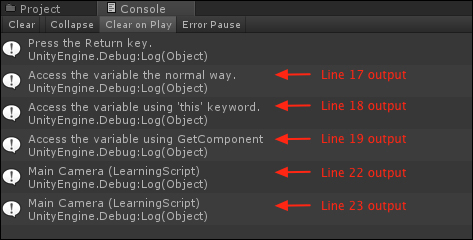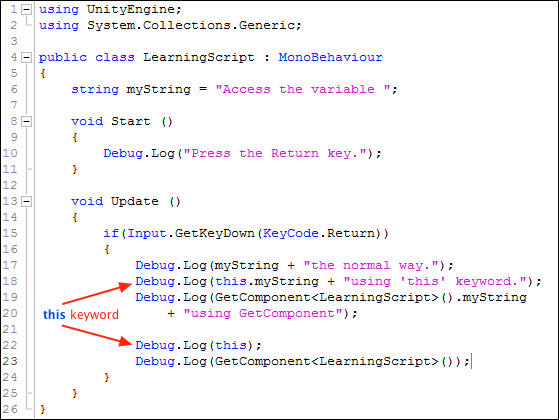Let's look at accessing a variable in LearningScript from inside LearningScript.
Here are the outputs in the Console:

An analysis of the code shown in the previous code screenshot is as follows:
Line 6: string myString = "Access the variable ";
Line 17: Debug.Log(myString + "the normal way.");
- This is how we have been accessing the value stored in a variable, by just using the variable name
- The
stringvalue inmyString,Accessing this variable, is substituted for the variable name myStringis being accessed without using Dot Syntax orGetComponent(), because a script always has access to its own variables and methods
Line 18: Debug.Log(this.myString + "using 'this' keyword.");
myStringis being accessed using Dot Syntax- The
thiskeyword refers to the current instance of the class, the current Component
Line 19: Debug.Log(GetComponent<LearningScript>().myString + "using GetComponent.");
myStringis being accessed using Dot Syntax again- This time, the generic
GetComponent<T>()method is retrieving theLearningScriptComponent
Line 22: Debug.Log(this);
- Using
this, the Component is sent to the Console so we can see thatthisis the currentLearningScriptComponent object
Line 23: Debug.Log(GetComponent<LearningScript>());
- Using
GetComponent<LearningScript>(), the Component is sent to the Console, so we can see this also is the currentLearningScriptComponent object - The
thiskeyword andGetComponent<LearningScript>()are both retrieving the sameLearningScriptComponent object
Whoa!! What's with line 18?
Notice item 1 in the graphic under the section, Accessing a Component's own variables and methods? This is the usual way we will access variables and methods in the current script; no Dot Syntax required. This is how we've been doing it from the beginning of this book. It's how we will probably continue to access them. However, we do have the option of accessing the variables and methods in the current Component object using Dot Syntax.
As you can see from the output of lines 17 and 18, the value stored in myString is substituted no matter how we access myString.
So if we really wanted to, we could use the GetComponent() method to retrieve the current Component object of the LearningScript class in memory, then use Dot Syntax to access myString. However, C# provides a shortcut to get the current Component object by using the this keyword.
Item 2 in the graphic is the syntax used in line 18. In this example, the keyword this simply means the current instance object of the LearningScript class, the current Component.
Now we start to just touch on the real power of Dot Syntax, communicating with other objects to access variable data and methods. We will now communicate with another Component on the same GameObject, the Main Camera. Remember, LearningScript is attached to the Main Camera already. The following diagram will explain how this is done:


